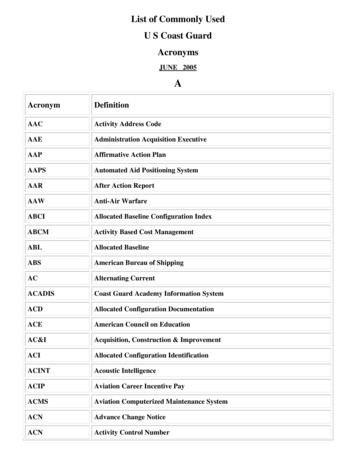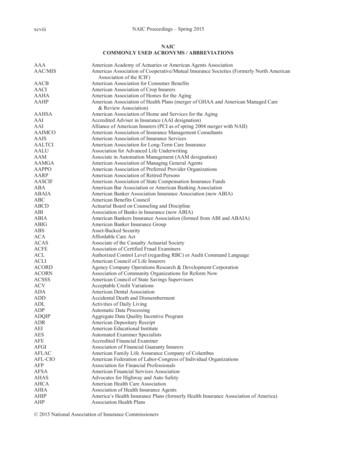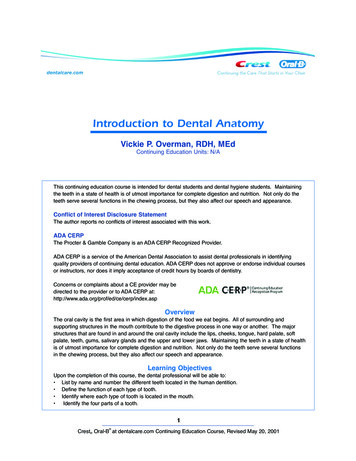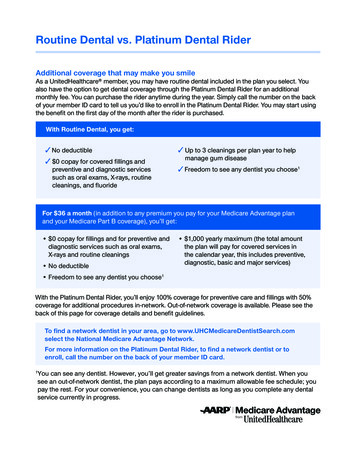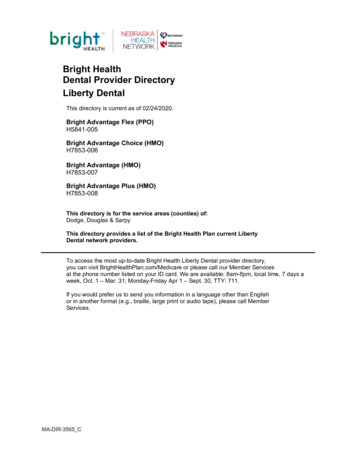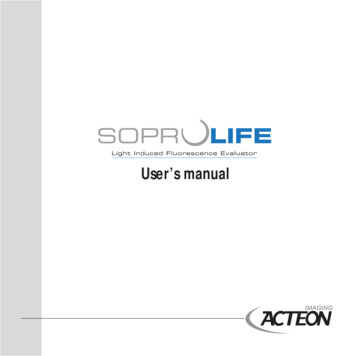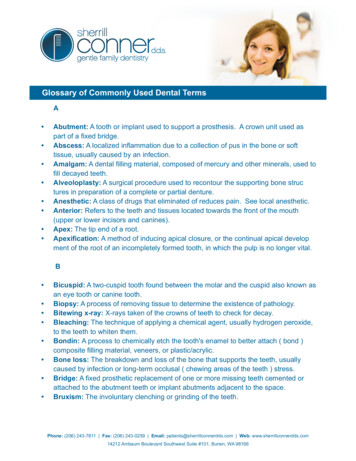
Transcription
Glossary of Commonly Used Dental TermsA Abutment: A tooth or implant used to support a prosthesis. A crown unit used aspart of a fixed bridge.Abscess: A localized inflammation due to a collection of pus in the bone or softtissue, usually caused by an infection.Amalgam: A dental filling material, composed of mercury and other minerals, used tofill decayed teeth.Alveoloplasty: A surgical procedure used to recontour the supporting bone structures in preparation of a complete or partial denture.Anesthetic: A class of drugs that eliminated of reduces pain. See local anesthetic.Anterior: Refers to the teeth and tissues located towards the front of the mouth(upper or lower incisors and canines).Apex: The tip end of a root.Apexification: A method of inducing apical closure, or the continual apical development of the root of an incompletely formed tooth, in which the pulp is no longer vital.B Bicuspid: A two-cuspid tooth found between the molar and the cuspid also known asan eye tooth or canine tooth.Biopsy: A process of removing tissue to determine the existence of pathology.Bitewing x-ray: X-rays taken of the crowns of teeth to check for decay.Bleaching: The technique of applying a chemical agent, usually hydrogen peroxide,to the teeth to whiten them.Bondin: A process to chemically etch the tooth's enamel to better attach ( bond )composite filling material, veneers, or plastic/acrylic.Bone loss: The breakdown and loss of the bone that supports the teeth, usuallycaused by infection or long-term occlusal ( chewing areas of the teeth ) stress.Bridge: A fixed prosthetic replacement of one or more missing teeth cemented orattached to the abutment teeth or implant abutments adjacent to the space.Bruxism: The involuntary clenching or grinding of the teeth.Phone: (206) 243-7811 Fax: (206) 243-0259 Email: patients@sherrillconnerdds.com Web: www.sherrillconnerdds.com14212 Ambaum Boulevard Southwest Suite #101, Burien, WA 98166
C Calculus: The hard deposit of mineralized plaque that forms on the crown and /orroot of the tooth. Also referred to as tartar.Canine tooth: The second tooth from the big front tooth, commonly called the eyetooth.Cantilever Extension: Part of a fixed prosthesis that is supported at one end only.Cap: Another term for crown; usually referring to a crown for a front tooth.Caries: The correct technical term for decay which is the progressive breaking downor dissolving of tooth structure, caused by the acid produced when bacteria digestsugars.Cavity: A layman’s term for decay. Also, the dental term for the hale that is left afterthe decay has been removed.Cement: A special type of glue used to hold a crown in it’s place. It also acts as aninsulator to protect the tooth’s nerve.Cementum: The very thin, bonelike structure that covers the root of the tooth.Clenching: The forceful holding together of the upper and lower teeth, which placesstress on the ligaments that hold the teeth to the jawbone and the lower jaw to theskull.Complex rehabilitation: The extensive dental restoration involving 6 or more unitsof crown and/or bridge in the same treatment plan. Using full crowns and/or fixedbridges which are cemented in place, that your dentist will rebuild natural teeth, fill inspaces where teeth are missing and establish conditions which allow each tooth tofunction in harmony with the occlusion ( bite ).Composite: A tooth-colored filling made of plastic resin or porcelain.Consultation: A diagnostic service provided by a dentist other than the treatingdentist.Cosmetic dentistry: Any dental treatment or repair that is solely rendered toimprove the appearance of the teeth or mouth.Crown: The portion of a tooth that is covered by enamel. Also a dental restorationthat covers the entire tooth and restores it to its original shape.Crown lengthening: A surgical procedure exposing more of the tooth for restorativepurposes.Curettage: A deep scaling of that portion of the tooth below the gum line. Purpose isto remove calculus and infected gum tissue.Cuspid: See canine tooth.Cusp(s): The protruding portion(s) of a tooth’s chewing surface.Phone: (206) 243-7811 Fax: (206) 243-0259 Email: patients@sherrillconnerdds.com Web: www.sherrillconnerdds.com14212 Ambaum Boulevard Southwest Suite #101, Burien, WA 98166
D Decay: see cariesDeciduous: See primary teethDental Floss: A thin, nylon string, waxed or unwaxed, that is inserted between theteeth to remove food and plaque.Dental hygienist: A dental professional specializing in cleaning the teeth by removing plaque, calculus, and diseased gum tissue. He/She acts as the patients guide inestablishing a proper oral hygiene program.Dentin: The part of the tooth that is under both the enamel which covers the crownand the cementum which covers the root.Dentition: The teeth in the dental arch.Denture: A removable appliance used to replace teeth. A complete denture replacesall of the upper teeth and/or all the lower teeth.DDS: Doctor of Dental Surgery or DDS, Doctor of Dental Medicine. Degrees givento dental school graduates. Both degrees are the same particular dental schoolsidentify at their discretion their graduates as DMD or DDS.Diastema: A space, such as one between two adjacent teeth in the same dentalarch.Distal: Farther from any part of reference.Direct pulp cap: The procedure in which the exposed pulp is covered with a dressing or cement that protects the pulp and promotes healing and repair.Dry socket (osteitis): A localized inflammation of the tooth socket following anextraction due to infection and lack of formation of a blood clot. Often due to smokingor excessive rinsing after an extraction.E Enamel: The hard, calcified (mineralized) portion of the tooth which covers thecrown. Enamel is the hardest substance in the body.Endodontics: The dental specialty that deals with injuries to or diseases of the pulp,or nerve, of the tooth.Endodontist: A dentist who deals with the cause, prevention, diagnosis, and treatment or injuries and diseases that affect the dental pulp , tooth root, and periapicaltissue.Equilibration: (occlusal adjustment) The achievement of a balance between opposing teeth or forces by adjustive grinding of an interfering tooth structure during thefunctional stroke.Extraction: The removal of a tooth.Excision: Surgical removal of bone or tissue.Extosis: The overgrowth of normal bone.Phone: (206) 243-7811 Fax: (206) 243-0259 Email: patients@sherrillconnerdds.com Web: www.sherrillconnerdds.com14212 Ambaum Boulevard Southwest Suite #101, Burien, WA 98166
Extracoronal: The outside crown of the tooth.Extraoral: The outside of the mouth.F Facial: Pertaining to or toward the face ( Buccal, Labial ).Filling: Material used to fill cavity or replace part of a tooth.Fissure: A deep ditch or cleft in the surface of the teeth.Floss: see dental floss.Fluoride: A chemical compound used to prevent dental decay, utilized in fluoridatedwater systems and/or applied directly to the teeth.Frenum: Muscle fibers covered by a mucus membrane that attaches the check, lipsand or tongue to associated dental mucous.Frenectomy: The removal of a frenum.G Gingiva: The soft tissue that covers the jawbone. Also referred to as the gums.Gingivectomy: Removal of excessive gingiva. May be necessary to access toothstructure during a restorative procedure.Gingivitis: An inflammation or infection of the gingiva; the initial stage of gumdisease.Gingivoplasty: A surgical procedure to reshape or repair the gingiva (gum).Graft: A piece of tissue or synthetic material placed in contact with tissue to repair adefect or supplement a deficiency.Gum: see gingiva.Gum Disease: see gingiva.H Hemisection: The surgical separation of a multirooted tooth through the furcationarea in such a way that the blocked, defective, or periodontally affected root or rootsmay be removed along with the associated portion of the crown.High noble metal: See metal, classification of.I Immediate denture: A denture constructed for immediate placement after removal ofthe remaining teeth.Impacted tooth: An unerupted or partially erupted tooth that is positioned againstbone or soft tissue so that total eruption is unlikely.Phone: (206) 243-7811 Fax: (206) 243-0259 Email: patients@sherrillconnerdds.com Web: www.sherrillconnerdds.com14212 Ambaum Boulevard Southwest Suite #101, Burien, WA 98166
Implant: An artificial device, usually make of a metal alloy or ceramic material, that isimplanted within the jawbone as a means to attach an artificial crown, denture , orbridge.Incipient: Dental carries in an early stage of development, often not requiring immediate restorations.Incisal: Pertaining to the cutting edges of incisor and cuspid teeth.Incision and Drain: (I and D) A sweeping incision made through the core of a lesionto allow draining of infection, and removal of any abnormal or unhealthy tissue.Indirect pulp cap: A procedure in which the nearly exposed pulp as covered with aprotective dressing to protect the pulp from additional injury and to promote healingand repair via formation of secondary dentin.Inlay: A cast gold filling that is used replace part of the tooth.Interproximal: The area between two adjacent teeth.Intracoronal: The area within a crown of a tooth.Intraoral: The inside of a mouth.L Labial: The area pertaining to or around the lip.Lingual: The area pertaining to or around the tongue.Local Anesthetic: The injection given in the mouth to numb the areas where a toothor area needs a dental procedure. Often referred to as Novocain.M Malocclusion: The improper alignment of biting or chewing surfaces of upper andlower teeth.Mandible: The lower jaw.Maryland bridge: The trade name that becomes synonymous with any resin bondedfixed partial denture (bridge).Mastication: The act of chewing.Maxilla: The upper jaw.Mesial: Toward or situated in the middle.Metals, classification of: The noble metal classification system has been adoptedas a more precise method of reporting various alloys in dentistry commonly used incrowns, bridges, and dentures. These alloys contain varying percentages of Gold,Palladium, and/or Platinum. High noble contains more than 60% of Gold, Palladiumand/or Platinum (with at least 40% Gold); noble contains more than 25% Gold, Palladium and/or Platinum; predominately base less than 25% Gold, Palladium and/orPlatinum.Phone: (206) 243-7811 Fax: (206) 243-0259 Email: patients@sherrillconnerdds.com Web: www.sherrillconnerdds.com14212 Ambaum Boulevard Southwest Suite #101, Burien, WA 98166
Molars: The broad, multicusped back teeth, used for grinding food are consideredthe largest teeth in the mouth. In adults there are a total of twelve molars (includingthe four wisdom teeth, or third molars), three on each side of the upper and lowerjaws.N Nitrous oxide: A controlled mixture of nitrogen and oxygen gases (N2O) that isinhaled by the patient in order to decrease sensitivity to pain. Also referred to aslaughing gas. Novocain: A generic name for the many kinds of anesthetics used in the dentalinjection, such as Xylocaine, Lidocaine, or Novocaine. See local anesthetic.O Occlusal x-ray: An intraoral x-ray taken with the film held between the teeth in bitingposition.Occlusal surface: The chewing surface of the back teeth.Occlusion: Any contact between biting or chewing surfaces of upper and lowerteeth.Onlay: A cast gold or porcelain filling that covers one or all of the tooth’s cusps.Oral surgery: The removal of teeth and the repair and treatment of other oral problems, such as tumors and fractures.Orthodontics: A specialized branch of dentistry that corrects malocclusion andrestores the teeth to proper alignment and function. There are several different typesof appliances used in orthodontics, one of which is commonly referred to as braces.Overbite: A condition in which the upper teeth excessively overlap the lower teethwhen the jaw is closed. This condition can be corrected with orthodontics.P Palate: The hard and soft tissues forming the roof of the mouth.Palliative: Treatment that relieves pain but is NOT curative.Panorex: An extraoral full-mouth X-ray that records the teeth and the upper andlower jaws on one film.Partial denture: A removable appliance used to replace one or more lost teeth.Periodontist: The area of dentistry concerned with the prevention, diagnostic, andtreatment of periodontal disease.Phone: (206) 243-7811 Fax: (206) 243-0259 Email: patients@sherrillconnerdds.com Web: www.sherrillconnerdds.com14212 Ambaum Boulevard Southwest Suite #101, Burien, WA 98166
Pediatric dentistry: The specialized branch of dentistry that deals solely with treating the children’s dental disease. Also referred to as Pedodontics.Periapical: The area that surrounds the tip of a tooth.Pericoronitis: An inflammation of the gum tissue around the crown of a tooth,usually the third molar.Periodontal: Relating to the tissue and bone that supports the tooth (from peri,meaning “around”, and dont , “tooth”).Periodontal disease: The inflammation and infection of the gums, ligaments, bone,and other tissues surrounding the teeth. Gingivitis and periodontitis are the twomain forms of periodontal disease.Periodontal pocket: An abnormal deepening of the gingival crevice. It is causedwhen disease and infection destroy the ligament that attaches the gum to the toothand the underlying bone.Periodontal surgery: A surgical procedure involving the gums and jawbone.Intended to reduce periodontal disease.Periodontics: The dental specialty that deals with and treats the gum tissue andbone that supports the teeth. Includes implant placement.Periodontitis: Inflammation of the supporting structures of the tooth, including thegum, the periodontal ligament, and the jawbone.Periradicular: The area which surrounds a portion of the root of the tooth.Permanent teeth: The thirty-two adult teeth that replace the baby ,
Cosmetic dentistry: Any dental treatment or repair that is solely rendered to improve the appearance of the teeth or mouth. Crown: The portion of a tooth that is covered by enamel. Also a dental restoration that covers the entire tooth and restores it to its original shape. Crown lengthening: A surgical procedure exposing more of the tooth for restorative purposes. Curettage: A .


